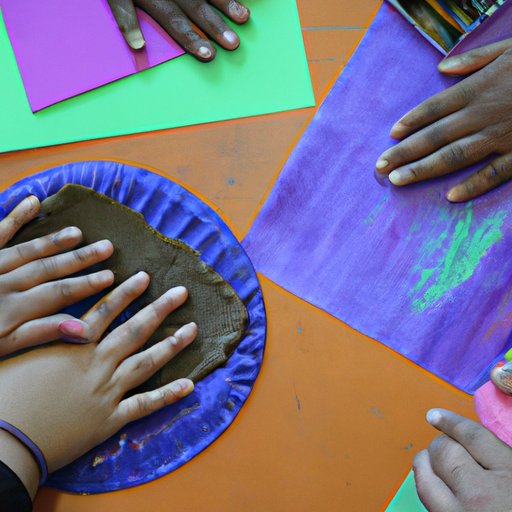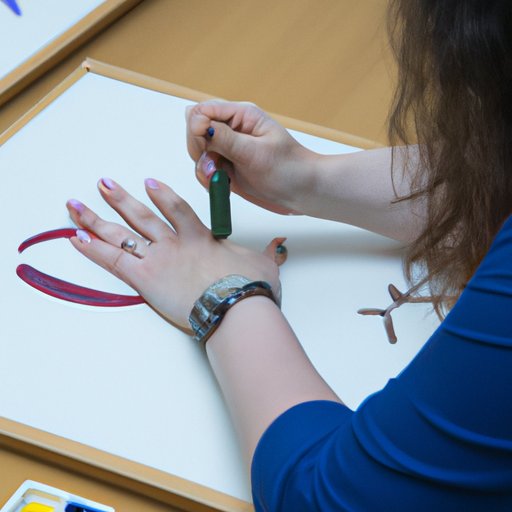Introduction
Art therapy is a form of psychotherapy that uses creative expression as a means of promoting mental and emotional well-being. It can be used to help individuals cope with stress, anxiety, depression, trauma, and other psychological issues. Becoming an art therapist requires a combination of educational and professional qualifications, as well as the necessary skills and knowledge to effectively practice art therapy.
Definition of Art Therapy
Art therapy is a form of psychotherapy that uses creative expression as a means of promoting mental and emotional wellbeing. Art therapists work with individuals to explore their feelings and thoughts through the use of visual arts, such as drawing, painting, sculpture, collage, photography, music, and drama. Art therapists help individuals find ways to express themselves, build self-esteem, process emotions, and gain insight into themselves and their lives.

Benefits of Becoming an Art Therapist
Becoming an art therapist can provide many benefits. Art therapists have the opportunity to work with individuals of all ages, backgrounds, and abilities. They get to help others heal and grow while also engaging in activities they are passionate about. Art therapists can also enjoy the flexibility of working in a variety of settings, including hospitals, schools, community centers, and private practices.
Education and Training Requirements for Becoming an Art Therapist
In order to become an art therapist, you must complete a combination of educational and professional qualifications. You will need to earn a degree in art therapy or psychology, as well as become licensed by the state in which you plan to practice. Additionally, you may wish to consider earning additional certifications or taking courses to further develop your skills and knowledge.
Degrees Needed to Become an Art Therapist
In order to become an art therapist, you will need to earn at least a master’s degree in art therapy or psychology. Depending on the state in which you plan to practice, you may need to obtain a doctoral degree in art therapy or psychology. Some states may also require you to complete a supervised clinical internship.
Professional Licensing Requirements
To become an art therapist, you must obtain a license from the state in which you plan to practice. The licensing process typically involves passing a written exam, completing a certain number of hours of supervised experience, and submitting a portfolio of your work. Depending on the state, you may also need to pass a criminal background check.
Additional Certifications and Courses
It is beneficial for art therapists to pursue additional certifications or take courses to further develop their skills and knowledge. Additional certifications may include certification in trauma-informed care or expressive arts therapy. Taking courses in areas such as ethics, assessment, and group dynamics can also help art therapists stay up-to-date on best practices.

Different Approaches to Art Therapy
There are several different approaches to art therapy. Each approach has its own unique set of techniques and goals. It is important for art therapists to understand the various approaches and determine which approach best suits the individual needs of the client.
Cognitive Behavioral Art Therapy
Cognitive behavioral art therapy (CBAT) is an evidence-based approach that combines cognitive behavioral therapy (CBT) and art therapy. CBAT helps clients identify and change negative thought patterns and behaviors, while using art as a tool to express emotions and gain insight into their experiences.
Psychodynamic Art Therapy
Psychodynamic art therapy is a form of psychotherapy that focuses on the unconscious processes and memories that shape behavior. Through the use of art materials, clients can explore unresolved conflicts and gain insight into their psychological functioning.
Humanistic Art Therapy
Humanistic art therapy is an approach that emphasizes the client’s potential for personal growth and self-actualization. This approach focuses on the client’s subjective experience and encourages them to use art to explore their feelings, beliefs, and values.
Person-Centered Art Therapy
Person-centered art therapy is an approach that emphasizes the importance of the therapeutic relationship between the client and the art therapist. This approach focuses on the client’s unique needs and goals, while helping them to gain insight into their own experiences.

Techniques Used in Art Therapy
Art therapists use a variety of techniques to help clients explore their feelings and thoughts. These techniques include drawing, painting, sculpting, collage, photography, music, and drama. Art therapists may also use traditional talk therapy techniques to help clients process their experiences.
Drawing
Drawing is one of the most common techniques used in art therapy. Art therapists may encourage clients to draw symbols, shapes, and abstract images to explore their feelings and thoughts. Drawing can help clients gain insight into their experiences and better understand their emotions.
Painting
Painting is another technique used in art therapy. Art therapists may provide clients with a variety of painting materials and encourage them to create images that express their feelings and thoughts. Painting can be a powerful way for clients to express themselves and gain insight into their experiences.
Sculpting
Sculpting is a technique used in art therapy that involves creating three-dimensional objects from clay, wood, or other materials. Art therapists may encourage clients to create sculptures that represent their thoughts and feelings. Sculpting can help clients gain insight into their experiences and better understand their emotions.
Collage
Collage is an art therapy technique that involves cutting and pasting different images and materials to create a larger image or design. Art therapists may encourage clients to create collages that represent their feelings and thoughts. Collage can be a powerful way for clients to express themselves and gain insight into their experiences.
Photography
Photography is a technique used in art therapy that involves taking pictures to express feelings and thoughts. Art therapists may encourage clients to take photographs that represent their experiences. Photography can help clients gain insight into their feelings and better understand their emotions.
Music
Music is a technique used in art therapy that involves playing or creating music to explore feelings and thoughts. Art therapists may encourage clients to create songs or instrumental pieces that express their experiences. Music can be a powerful way for clients to express themselves and gain insight into their experiences.
Drama
Drama is a technique used in art therapy that involves acting out situations or stories to explore feelings and thoughts. Art therapists may encourage clients to create scenes or improvisations that express their experiences. Drama can help clients gain insight into their feelings and better understand their emotions.
Creating a Safe and Supportive Environment for Clients
Art therapists must create a safe and supportive environment for their clients. This includes establishing clear boundaries, promoting self-expression, and providing reassurance and encouragement. Art therapists should also be aware of their own biases and be sure to remain nonjudgmental and open-minded when working with clients.
Establishing Boundaries
It is important for art therapists to establish clear boundaries with their clients. Art therapists should be sure to communicate their expectations, roles, and responsibilities in a clear and respectful manner. Establishing boundaries helps ensure that both the art therapist and the client feel safe and respected.
Promoting Self-Expression
Art therapists should promote self-expression in their clients. This includes encouraging clients to explore their feelings and thoughts through the use of art materials. Art therapists should also provide positive feedback and reinforcement to help clients feel confident in their ability to express themselves.
Providing Reassurance and Encouragement
It is important for art therapists to provide reassurance and encouragement to their clients. Art therapists should be sure to provide support and validation to help clients feel safe and secure in the therapeutic setting. Providing reassurance and encouragement can help clients feel more comfortable expressing themselves and exploring their feelings and thoughts.
Resources for Further Education and Development
There are many resources available to art therapists who wish to further develop their skills and knowledge. Books, conferences, and online courses are just some of the resources that can help art therapists stay up-to-date on best practices. Additionally, art therapists can join professional organizations and networks to connect with other art therapists and learn about new developments in the field.
Books
Books are a great resource for art therapists looking to further develop their skills and knowledge. There are a variety of books available that cover topics such as art therapy theory, techniques, and case studies. Reading books can help art therapists stay up-to-date on best practices and gain a deeper understanding of the field.
Conferences
Attending conferences is another way for art therapists to further develop their skills and knowledge. Conferences provide a great opportunity for art therapists to network with other professionals, learn about new developments in the field, and gain insights from experienced practitioners.
Online Courses
Online courses are a convenient and cost-effective way for art therapists to further develop their skills and knowledge. There are a variety of online courses available that cover topics such as ethics, assessment, and group dynamics. Taking online courses can help art therapists stay up-to-date on best practices and gain a deeper understanding of the field.

Marketing Yourself as an Art Therapist
Once you have completed your education and training, it is important to market yourself as an art therapist. Developing your professional network, utilizing social media platforms, and creating an online presence can help you reach potential clients and promote your services.
Developing Your Professional Network
Networking is an important part of marketing yourself as an art therapist. Connecting with other art therapists, mental health professionals, and healthcare providers can help you reach potential clients and promote your services. Participating in professional organizations and attending conferences are great ways to expand your network.
Utilizing Social Media Platforms
Social media platforms can be a useful tool for promoting yourself as an art therapist. Creating profiles on platforms such as Facebook, Twitter, and Instagram can help you reach potential clients and promote your services. It is important to be mindful of ethical considerations when using social media.
Creating an Online Presence
Creating an online presence is another way to market yourself as an art therapist. Developing a website and blog can help you reach potential clients and promote your services. It is also beneficial to list yourself on online directories and review sites to increase your visibility.
Conclusion
Becoming an art therapist requires a combination of educational and professional qualifications, as well as the necessary skills and knowledge to effectively practice art therapy. Art therapists should understand the different approaches to art therapy and be familiar with the techniques used in art therapy. Additionally, art therapists should create a safe and supportive environment for their clients and be sure to market themselves in order to reach potential clients. With the right education, training, and techniques, art therapists can make a positive difference in the lives of their clients.
(Note: Is this article not meeting your expectations? Do you have knowledge or insights to share? Unlock new opportunities and expand your reach by joining our authors team. Click Registration to join us and share your expertise with our readers.)
